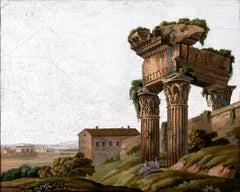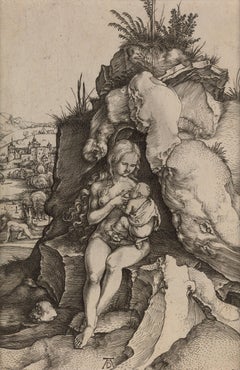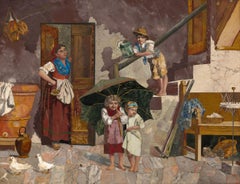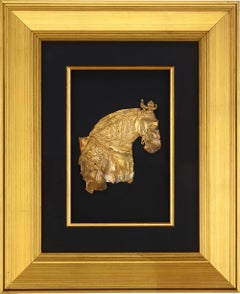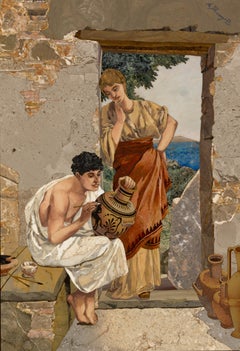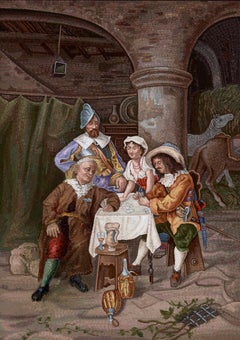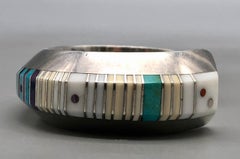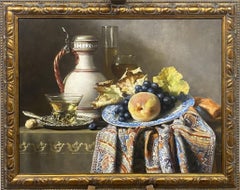M.S. Rau More Art
to
3
2
1
Overall Width
to
Overall Height
to
2
3
1
1
4
2
2
2
2
1
1
1
6
Temple of Vespasian and Titus Roman Micromosaic
Located in New Orleans, LA
The ruins of the ancient Roman Temple of Vespasian and Titus are the subject of this Italian micromosaic. Crafted in intricate detail, the scene is composed from hundreds of tiny gla...
Category
Late 19th Century More Art
Materials
Mosaic
The Penance of St. Chrysostom by Albrecht Dürer
By Albrecht Dürer
Located in New Orleans, LA
Albrecht Dürer
1471-1528 German
The Penance of St. Chrysostom
Monogrammed in the plate lower center "AD"
Copper engraving on laid paper
“Whatever was mortal in Albrecht Dürer li...
Category
15th Century and Earlier Old Masters More Art
Materials
Copper
Pietre Dure Plaque Of Village Children
Located in New Orleans, LA
Magnificent and colorful, this enchanting Florentine work of art is not a painting, but upon closer inspection is revealed to be a superb example of the intensive art of pietre dure....
Category
19th Century More Art
Materials
Stone, Marble
Gold Tang China Horse Head
Located in New Orleans, LA
This exceptional and rare rendering of a horse head, composed of gold over silver, hails from the illustrious Tang dynasty of China. The powerful Tang dynasty reigned for nearly 300 ...
Category
15th Century and Earlier Other Art Style More Art
Materials
Gold, Silver
Pietre Dure Plaque Of Ancient Artisan By Alberto Menegatti
Located in New Orleans, LA
A young man clad in classical robes paints an amphora vase as an attractive admirer observes him in this magnificent pietre dure plaque by Florentine artisan Alberto Menegatti. The work is emblematic of the charming scenes of rural life that were favored by Italian pietre dure artists. The superlative quality and beauty of the stone specimens utilized to create the composition distinguish this piece, and the artist’s ingenious use of the natural striations and inclusions in his stones allows him to convey texture and shadow to brilliant effect.
The art of pietre dure developed from the ancient art of opus...
Category
Early 20th Century More Art
Materials
Stone
Gamblers Italian Micromosaic
Located in New Orleans, LA
A friendly game of cards is the subject of this 19th-century Italian micromosaic. A special type of mosaic that uses incredibly small pieces of tesse...
Category
19th Century Other Art Style More Art
Materials
Glass, Mosaic
Related Items
Multi stone inlay bracelet
Located in Los Angeles, CA
Gibson Nez Multi Stone Inlay Bracelet
This geometric shaped bracelet, by award winning artist Gibson Nez, features a channel inlay design created with turquoise, lapis, coral, onyx ...
Category
1980s More Art
Materials
Silver
Still life with grapes , 50x65cm, oil on canvas
Located in Yerevan, AM
Still life with grapes , 50x65 cm, oil on canvas
If you don't need a frame, please let me know, shipping without a frame will be cheaper.
Category
2010s Old Masters More Art
Materials
Canvas, Oil
$2,062 Sale Price
25% Off
H 19.69 in W 25.6 in
Evening, dessert, 50x60 cm, oil on canvas
Located in Yerevan, AM
Evening, dessert, 50x60 cm, oil on canvas
If you don't need a frame, please let me know, shipping without a frame will be cheaper.
Category
2010s Old Masters More Art
Materials
Canvas, Oil
$2,062 Sale Price
25% Off
H 19.69 in W 23.63 in
Rare 19th Century Italian Micromosaic, the Capitoline Doves
Located in Vicoforte, IT
Beautiful 19th century Italian micromosaic. Also called minute mosaic or miniature mosaic or spun mosaic, it is a technique presented for the first time in Rome in 1775 in the worksh...
Category
1850s More Art
Materials
Mosaic
$17,470
H 17.72 in W 20.48 in D 2.37 in
Dutch Old Master Portrait of Maurits, Prince of Orange-Nassau, Oil on Panel
Located in London, GB
In 1607, the Delft city council decided to commission a portrait of Stadholder Maurits of Nassau for the town hall, with Michiel van Mierevelt as the chosen artist due to the passing...
Category
17th Century Old Masters Portrait Paintings
Materials
Oil, Wood Panel
$12,185
H 37.8 in W 33.47 in D 2.37 in
Portrait of a Lady in an Elaborate Ruff & Lace Coif c.1610-20, Dutch Old Master
Located in London, GB
This magnificent oil on panel portrait, presented by Titan Fine Art, is a splendid example of the sumptuous female portraits that were painted for members of the upper echelons of society during the early part of the 1600’s. The artist has rendered this portrait with meticulous attention to detail and the surface effects of the fine materials. The elaborate lace coif and cuffs are painstakingly delineated, as is the bold black damask, and sumptuous gold decoration of her skirt and stomacher, which is wonderfully preserved and quite remarkable considering the age of the work and the fact that darker pigments are particularly vulnerable to fading and wear. This work with its spectacular depiction of costume is of absolute quality, it can be rated as one of the best works in the artist’s oeuvre and as such it is an important and splendid example of Dutch portraiture.
The Dutch Golden Age of painting was a period in Dutch history, roughly spanning the 17th century, in which Dutch trade, science, military, and art were among the most acclaimed in the world. Dutch explorers charted new territory and settled abroad. Trade by the Dutch East-India Company thrived, and war heroes from the naval battles were decorated and became national heroes. During this time, The Dutch Old Masters began to prevail in the art world, creating a depth of realistic portraits of people and life in the area that has hardly been surpassed. The Golden Age painters depicted the scenes that their discerning new middleclass patrons wanted to see. This new wealth from merchant activities and exploration combined with a lack of church patronage, shifted art subjects away from biblical genres.
Dress was a key component in portraits, and the exuberant attire reiterates the incredible wealth of this woman. The sitter will have visited the artist’s workshop and inspected examples on display. They would have chosen the size and the sort of composition and on that basis negotiated the price – which would have also been determined by the complexity of the clothing and the jewels that were to be depicted, and by the materials to be used. When all was considered, this portrait would have cost the sitter (or her husband) a substantial sum.
The colour black was regarded as humble and devout yet at the same time refined and sophisticated and the most expensive colour of fabric to dye and to maintain. Citizens spent fortunes on beautiful black robes. Such uniformity must also have had a psychological side-effect and contributed to a sense of middle-class cohesion; the collective black of the well-to-do burgess class will have given its members a sense of solidarity. The colour was always an exciting one for artists and when this portrait was painted there were at least fifty shades of it, and as many different fabrics and accoutrements. Artists went to great lengths to depict the subtle nuances of the colour and the fabrics and textures and how they reflected light and it was an ideal background against which gold and crisp white lace could be juxtaposed to dramatic effect.
The sitter is either a married women or a widower as is evident by the clothing that she wears and the position, toward her right, it is highly likely that this portrait was once a pendant that hung on the right-hand side of her husband’s portrait as was convention at the time. She wears a vlieger which was a type of sleeveless over-gown or cape worn by well-to-do married women in the late 16th and early 17th centuries. Variations with short sleeves or high shoulder rolls are known. Sometimes sleeves were attached with aiglets, and often slits were made to allow belts or the hands to pass through. Three-piece vlieger costumes of this kind were standard items of clothing in portraits of the women of the civic elite in the period 1600-40 and was a variant of the Spanish ‘ropa’ and served as a trademark of well-to-do married burgher women. Girls and unmarried woman, including beguines, wore a bouwen (a dress with a fitted bodice and a skirt that was closed all round) instead. This clear distinction between apparel for married and unmarried women is clear not only from inventories and trousseau lists, but also from contemporary sources such as the Dutch Spanish dictionary published by Juan Rodrigues in 1634. In it, a bouwen is described as a ‘ropa de donzella’ (over-gown worn by a virgin) and a vlieger as a ‘ropa de casada’ (overgown worn by a married woman). It is striking how few women are depicted wearing a bouwen, unless they are part of a group, family or children’s portrait and it can therefore be assumed that independent portraits of unmarried women were seldom commissioned. It is also believed that the clothing worn in these portraits existed and were faithfully reproduced when cross-referenced with the few exact documents. These sources also demonstrate that clients wanted their clothing to be depicted accurately and with this in mind precious garments and jewels were often left in the painter’s studio.
The prominent white lawn molensteenkraag (or millstone ruff) is held up by a wire supportasse and was reserved only for the citizens that could afford this luxurious item that often required 15 meters of linen batiste. The fabulous wealth of this sitter is also evident by the elaborate lace coif and cuffs which have been exquisitely depicted; lace was often literally copied by artists in thin white lines over the completed clothing.
The gold bracelet with jewels is a type that was evidently fashionable as it is seen in a number of portraits during the 1610s and 1620. Clothing and jewellery were prized possessions and were often listed in inventories of estates and passed down from generation to generation. There were a great number of jewellers of Flemish origin working at all the courts and cities of Europe, competing with the Italians, and then the French, adapting themselves to the tastes and positions of their patrons and the raw materials available in the country where they worked. The fashion for jewels “in the Flemish style” succeeded that of the Italian style.
Cornelis van der Voort, who was probably born in Antwerp around 1576, came to Amsterdam with his parents as a child. His father, a cloth weaver by trade, received his citizenship in 1592. It is not known who taught the young Van der Voort to paint, but it has been suggested that it was either Aert Pietersz or Cornelis Ketel. On 24 October 1598 Van der Voort became betrothed to Truytgen Willemsdr. After his first wife’s death he became betrothed to Cornelia Brouwer of Dordrecht in 1613. In addition to being an artist, Van der Voort was an art collector or dealer, or both. In 1607 he bought paintings from the estate of Gillis van Coninxloo, and after an earlier sale in 1610 a large number of works he owned were auctioned on 7 April 1614. Van der Voort is documented as appraising paintings in 1612, 1620 and 1624. In 1615 and 1619 he was warden of the Guild of St Luke. He was buried in Amsterdam’s Zuiderkerk on 2 November 1624, and on 13 May 1625 paintings in his estate were sold at auction.
Van der Voort was one of Amsterdam’s leading portrait painters in the first quarter of the 17th century. Several of his group portraits are known. It is believed that he trained Thomas de Keyser (1596/97-1667) and Nicolaes Eliasz Pickenoy (1588-1650/56). His documented pupils were David Bailly (c. 1584/86-1657), Louis du Pré...
Category
17th Century Old Masters Portrait Paintings
Materials
Oil, Wood Panel
On Hold
$24,573
H 44.89 in W 35.83 in D 2.37 in
Portrait of Gentleman Blue & Cloak, Portrait of Lady, Fine Carved Gilded frames
Located in London, GB
Portrait of a Gentleman with Blue Cloak and Portrait of a Lady in Russet Dress c.1697
Thomas Murray (1663-1735)
These fascinating portraits are exquisite examples of portraiture in ...
Category
17th Century Old Masters Portrait Paintings
Materials
Oil, Canvas
$27,266
H 37.8 in W 33.47 in D 2.76 in
Untitled "Marble Fragment 3" 2019, acrylic, landscape, wall sculpture, clouds
Located in Jersey City, NJ
Untitled "Marble Fragment 3" 2019, acrylic, landscape, wall sculpture, clouds, purple, blue
Category
2010s Contemporary Abstract Sculptures
Materials
Marble
$220
H 7 in W 7 in D 0.75 in
Portrait of a Gentleman in Grey Coat & White Cravat, Oil on canvas Painting
Located in London, GB
This exquisite work, presented by Titan Fine Art, is by the notable artist Hans Hysing, who was a noteworthy painter in England; it is significant in its q...
Category
18th Century Old Masters Portrait Paintings
Materials
Canvas, Oil
$9,762
H 36.62 in W 31.5 in D 1.97 in
Bust of a young woman / - Beauty of youth -
Located in Berlin, DE
Anonymous, Bust of a young woman, c. 1900, artificial marble and gray onyx marble. 37 cm (height) x 37 cm (width) x 22 cm (depth), weight 17.2 kg. Signed “GURRINI” on the reverse.
-...
Category
Early 1900s Realist Figurative Sculptures
Materials
Marble
$885 Sale Price
20% Off
H 14.57 in W 14.57 in D 8.67 in
Oil Portrait of a Victorian Lady, c. 1850
Located in Chicago, IL
Painted in the 19th century, this exquisite miniature portrait wonderfully exemplifies realism in traditional oil painting. The small artwork is painted in the conventional portraiture style of the Old Masters, and achieves soft realism with fine brushwork and a subdued, neutral palette. The half length portrait depicts a fine Victorian woman dressed in all black with a delicate lace collar and bonnet. She wears a ruby broach...
Category
Mid-19th Century Old Masters More Art
Materials
Oil
Micromosaic and Pink Shell Cameo Brooch.Early 20th century. Signed F.A.P. Florence
Located in Firenze, IT
Brooch with Cameo and Micromosaic
Late 19th century - early 20th century
Materials: Shell cameo, micromosaic in glass tesserae, metal alloy (likely brass)
Central cameo depicting a...
Category
Late 19th Century Art Nouveau More Art
Materials
Mosaic, Intaglio
$151
H 0.99 in W 0.99 in
